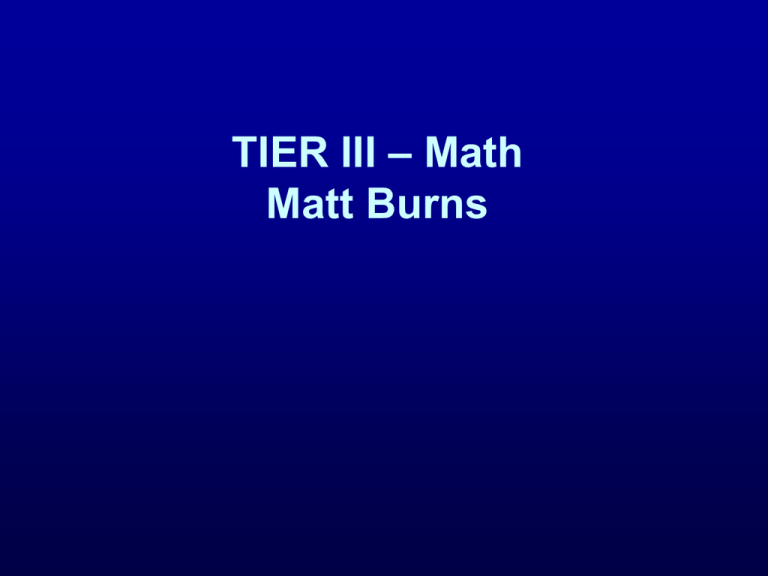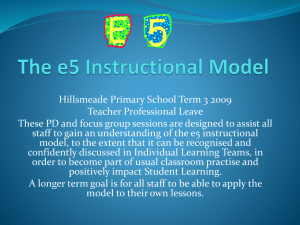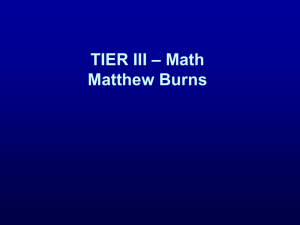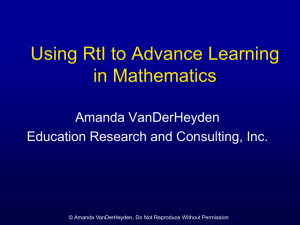to access those materials
advertisement

TIER III – Math Matt Burns Remember Algebra • Logical patterns exist and can be found in many different forms. • Symbolism is used to express generalizations of patterns and relationships. • Use equations and inequities to express relationships. • Functions are a special type of relationship (e.g., one-more-than). VandeWalle, 2008 © Amanda VanDerHeyden, Do Not Reproduce Without Permission Instructional Hierarchy: Stages of Learning Acquisition Proficiency Generalization Adaption Learning Hierarchy Slow and Accurate but Can apply to Can use information inaccurate slow novel setting to solve problems Instructional Hierarchy Modeling Novel Discrimination Problem solving Explicit practice opportunities Independent practice Timings Immediate feedback training Differentiation training Simulations instruction Immediate corrective feedback Haring, N. G., & Eaton, M. D. (1978). Systematic instructional procedures: An instructional hierarchy. In N. G. Haring, T. C. Lovitt, M. D. Eaton, & C. L. Hansen (Eds.) The fourth R: Research in the classroom (pp. 23-40). Columbus, OH: Charles E. Merrill. Instructional Hierarchy for Conceptual Knowledge Phase of Learning Acquisition Examples of Explicit Instruction appropriate in basic principles instructional and concepts activities Modeling with math manipulatives Proficiency Generalization Independent practice with manipulatives Instructional games Use concepts to with different solve applied stimuli problems Immediate Provide word feedback on the problems for the speed of concepts Immediate responding, but corrective feedback delayed feedback on the accuracy. Contingent reinforcement for speed of response. Adaption Instructional Hierarchy for Procedural Knowledge Phase of Learning Examples of appropriate instructional activities Acquisition Proficiency Explicit instruction Independent in task steps practice with written skill Modeling with written problems Immediate feedback on the speed of the response, but delayed feedback on the accuracy. Immediate feedback on the accuracy of the work. Contingent reinforcement Generalization Adaption Apply number operations to applied problems Use numbers to solve problems in the classroom Complete real and contrived number problems in the classroom Phase of Learning for Math Conceptual Procedural Acquisition Proficiency Generalization Adaption Acquisition Proficiency Generalization Adaption What does the kid need? Assessment Rocks! © Amanda VanDerHeyden, Do Not Reproduce Without Permission Skill by Treatment Interaction • Instructional Level (Burns, VanDerHeyden, & Jiban, 2006) • 2nd and 3rd grade -14 to 31 Digits Correct/Min • 4th and 5th grade - 24 to 49 Digits Correct/Min Type of Intervention Baseline Skill Level Acquisition Fluency Mean Phi k Median PND Frustration 21 97% .84 Instructional 15 66% .49 Frustration 12 62% .47 Instructional NA Conceptual Assessments © Amanda VanDerHeyden, Do Not Reproduce Without Permission Assessing Conceptual Knowledge Concept Oriented CBM • Monitoring Basic Skills Progress-Math Concepts and Applications (Fuchs, Hamlett, & Fuchs, 1999). • 18 or more problems that assess mastery of concepts and applications • 6 to 8 minutes to complete Conceptual CBM (Helwig et al. 2002) or Application? Conceptual Assessment Ask students to judge if items are correct – 10% of 5-year-old children who correctly counted did not identify counting errors in others (Briars & Siegler, 1984). Provide three examples of the same equation and asking them to circle the correct one Provide a list of randomly ordered correct and incorrect equations and ask them to write or circle “true” or “false” (Beatty & Moss, 2007). Conceptual Intervention • John – 8th grade African-American female • History of math difficulties (6th percentile) • Could not learn fractions Assessment • 0 correct on adding fractions probe • Presented sheet of fractions with two in each problem and asked which was larger (47% and 45% correct) • 0% reducing Step 1 – size of fractions • 1. I do • 2. We do • 3. You do • Comparing fractions with pie charts Fraction Comparison 100 90 Percentage Correct 80 70 60 50 40 30 20 10 0 1 2 3 4 5 6 7 8 Step 2 – Reducing Fractions • Factor trees (I do, we do, you do) 84 4 21 2 2 3 7 Reducing Fractions 100 90 80 Percent Correct 70 60 50 40 30 20 10 0 -10 1 2 3 4 5 6 7 8 Reducing Fractions 50 45 Digits correct per minute 40 35 30 25 20 15 10 5 0 -5 1 2 3 4 5 6 7 8 Conceptual Assessment Problem 1 Please use a picture to solve the problem 3 x 4 = ___ Problem 2 Please use a picture to solve the problem 5 x 6 =___ Vandewalle, 2008 Ratings for Problem 2 Counts with understanding Understands number sign Understands the facts of adding/ subtraction or multiplication/division of whole numbers Uses visual model (Correct relationship between diagram and problem) Uses an identifiable strategy Answers the problem correctly Ratings for Problem 2 Counts with understanding 4 Understands number sign 3 Understands the facts of adding/ subtraction or multiplication/division of whole numbers 3 Uses visual model (Correct relationship between diagram and problem) 2 Uses an identifiable strategy 1 Answers the problem correctly 4 © Amanda VanDerHeyden, Do Not Reproduce Without Permission From Objects to Numbers • • • • • • • Make Sets Count the number write the number Part-Part-Whole Fill the Chutes Broken Calculator Key Algebra – Pattern Match Algebra – Tilt or Balance © Amanda VanDerHeyden, Do Not Reproduce Without Permission What about Touch Math??? © Amanda VanDerHeyden, Do Not Reproduce Without Permission © Amanda VanDerHeyden, Do Not Reproduce Without Permission © Amanda VanDerHeyden, Do Not Reproduce Without Permission © Amanda VanDerHeyden, Do Not Reproduce Without Permission









